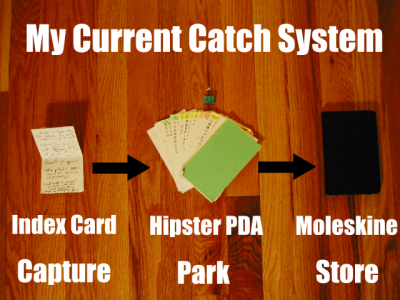My experiences putting Mind Performance Hack #1 into action await a later post, as I am planning to work with each hack for a suitable period of time before drawing conclusions as to its effectiveness or utility. Incidentally, I received a very nice note from Ron Hale-Evans, the primary author of Mind Performance Hacks. Hi, Ron! I hope that this series does not disappoint.
Hack #13, “Catch Your Ideas“, is the first hack of the Information Processing section of the book. Like a fair number of the hacks, it is by an author other than Ron Hale-Evans, in this case, Lion Kimbro. Lion is the author of a curious screed entitled How to Make a Complete Map of Every Thought You Think, a text that does a rather good job delivering what it promises. I scanned through it a few years back and found some definitely interesting bits, but Kimbro says it best himself:
If you do the things described in this book, you will be IMMOBILIZED for the duration of your commitment.The immobilization will come on gradually, but steadily. In the end, you will be incapable of going somewhere without your cache of notes, and will always want a pen and paper w/ you . . . You will not only be immobilized in the arena of action, but you will also be immobilized in the arena of thought. This appears to be contradictory, but it’s not really. When you are writing down your thoughts, you are making them clear to yourself, but when you revise your thoughts, it requires a lot of work- you have to update old ideas to point to new ideas. This discourages a lot of new thinking. There is also a “structural integrity” to your old thoughts that will resist change. You may actively not-think certain things, because it would demand a lot of note keeping work.
Kimbro also describes the positive aspects of his method, but I am far too familiar with (and prone to) system paralysis, the syndrome where some system one is using begins to eat up ever-larger portions of one’s time and life. When I first started keeping journals I was laboriously detailed, attempting to capture every minutia of thought and memory. Such compulsive devotion is only sustainable for limited periods of time.
Hack #13 could be considered HtMaCMoETYT-light, and as such is much more practical than the full system as part of a balanced, mentally healthy lifestyle. It proposes a “catch”, a system to capture and store all those cool ideas that flit through one’s head while one is engaged in hum-drum quotidiana.
It suggests using loose-leaf, ruled 8.5″ x 11″ paper divided into three columns, specifying a broad subject, a “hint” or keyphrase, and the idea itself. One is to always carry such a sheet around and, right after having an interesting thought, one is to capture it in just enough detail so that one can recall it later. These capture sheets are processed regularly, and the ideas copied onto other sheets of paper for each subject and filed. A system for numbering and referencing the ideas is mentioned as well; this seems to be part of Kimbro’s larger system, but its utility as part of this catch system is not immediately apparent to me.
My current system is somewhat related, if not quite as formal. My note-taking apparatus consists of a carefully organized and binder-clipped pack of index cards (a.k.a. a Hipster PDA) and an unruled Moleskine notebook. If I am engaged in an activity where I don’t want anything bulky in my pockets (like taking a lunchtime walk), I’ll stick one or two folded index cards in my pocket and scribble down any ideas that I don’t want to lose.
In theory, the scribbles are transferred either to the Hipster (if they are practical actions or goals) or to the Moleskine (if they are interesting ideas that I want to preserve for future contemplation). In practice, though, the scribble-cards often don’t get transcribed in a timely fashion and begin to clutter up my binder clip. The notes in the Moleskine are not organized beyond their chronological capture-dates. Reviewing them can be very interesting, but it’s difficult to assess them in any coherent fashion.
I’ll be modifying this hack as I put it into practice. For the first week I’ll continue to use my current system for capture. Rather than the Moleskine, though, I’ll transfer the notes to larger sheets of paper for each subject (unruled, as I have a prejudice against sloppily-printed blue lines cramping my style).
For the second week, I’ll shift to carrying full sheets of paper around with me (I might even suppress my aesthetics and use ruled, if I have some in the closet) instead of index cards, and compare the experience. For both weeks, I’ll be focusing on paying attention to my ideas as they occur and making notes about them as close to occurrence as possible. I’ve noticed that ideas come in clusters: once I’ve written down one, several more are likely to occur to me in fairly short order.
This hack is strictly paper-oriented: the issues around using computers for idea capture and storage will have to be left as fodder for a later post.

